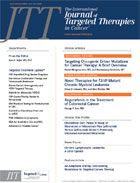PI3K Inhibitor Active in Multiple Lymphoma Types
A dual-target PI3 kinase inhibitor demonstrated activity in several types of relapsed and refractory non-Hodgkin lymphoma.
Steven M. Horwitz, MD
A dual-target PI3 kinase (PI3K) inhibitor demonstrated activity in several types of relapsed and refractory non- Hodgkin lymphoma (NHL), according to results of a phase I clinical trial presented at the 2013 American Society of Clinical Oncology (ASCO) Annual Meeting.
Nearly half of patients evaluable for efficacy had objective responses to IPI-145, which achieved responses in all lymphoma subgroups except for aggressive NHL. “At least preliminarily, it appears that IPI-145 is well tolerated in patients with a number of advanced hematologic malignancies at doses up through 75 mg BID,” said Steven M. Horwitz, MD, medical oncologist at Memorial Sloan-Kettering Cancer Center in New York City. “We observed rapid responses across a spectrum of lymphoid malignancies, including B- and T-cell lymphomas.”
The PI3K pathway has a key role in lymphocyte signaling. The delta isoform is involved in T-cell and B-cell signaling, and the gamma isoform is involved primarily in mediating neutrophil activity, but also in T-cell signaling and chemokine activation, said Horwitz.
IPI-145 inhibits both the delta and gamma isoforms of PI3K and exhibits selectivity for PI3 kinases over other protein and lipid kinases. Laboratory studies have indicated that the molecule also inhibits survival in malignant T and B cells.
Horwitz reported findings from a phase I dose-escalation study involving patients with various types of advanced hematologic malignancies. Eligible patients had progressed during treatment, were intolerant or ineligible for standard therapies, or had conditions for which no standard therapy existed. Upon enrollment in the trial, they received IPI-145 orally twice daily until development of intolerance or progression.
Patients were enrolled in dose-defined cohorts starting at 8 mg twice daily and continuing to a maximum of 100 mg twice daily. Dose-limiting toxicity occurred at 100 mg twice daily (rash and elevated liver enzymes), and 75 mg twice daily emerged as the maximum tolerated dose, which is being evaluated in expansion cohorts. Additionally, the 25-mg twice-daily dosage demonstrated activity in low-grade, indolent lymphomas, and separate expansion cohorts are receiving that dosage.
Lymphoma subtypes enrolled thus far comprise indolent NHL (26), T-cell lymphoma (17), aggressive B-cell lymphoma (13), mantle cell lymphoma (9), and Hodgkin lymphoma (3). The safety evaluation included patients with other malignancies, resulting in a total safety population of 117 patients, including 68 patients with lymphoma. The efficacy population consisted of 73 patients, including 38 with B-cell lymphoma and nine with T-cell lymphoma.
The B-cell subgroup started IPI-145 a median duration of 3.5 months from their previous therapy, and the T-cell subgroup began treatment less than a month after their previous therapy. More than 80% of the patients had a treatment history of three or more prior systemic regimens.
The B-cell group had received IPI-145 for a median duration of 2.7 months and the T-cell group for 1.4 months. Horwitz reported that 27 of 51 patients with B-cell lymphoma and eight of 17 patients with T-cell lymphoma remained on treatment. About half of discontinuations occurred as a result of disease progression and about one-fourth of discontinuations resulted from adverse events (AEs).
All but five of the lymphoma patients had one or more AEs, most of which were considered treatment-related. Additionally, two-thirds of the B-cell group and half of the T-cell group had grade ≥3 AEs, and about one-third of the patients had serious AEs.
The most common AEs were elevated liver enzymes, pyrexia, fatigue, neutropenia, cough, diarrhea, and nausea (≥20% of patients). Additionally, rash, vomiting, dyspnea, headache, edema, thrombocytopenia, and upper respiratory infection occurred in 10% to 20% of patients. Most AEs were grade 1 or 2 severity, with the exception of elevated liver enzymes and neutropenia, which were predominantly grade 3/4.
Of 47 patients evaluable for efficacy, objective responses occurred in 21 (44.6%), including six complete responses. Responses were observed in 13 of 19 patients with indolent NHL, four of six with mantle cell lymphoma, three of nine with T-cell lymphoma, and one of three with Hodgkin lymphoma. None of the 10 evaluable patients with aggressive NHL had objective responses. Horwitz said that 20 of 21 responses occurred by the first assessment, which occurred after about 2 months of treatment.
Horwitz SM, Flinn I, Patel MR, et al. Preliminary safety and efficacy of IPI-145, a potent inhibitor of phosphoinositide-3-kinase-δ,γ, in patients with relapsed/ refractory lymphoma.J Clin Oncol

Examining the Non-Hodgkin Lymphoma Treatment Paradigm
July 15th 2022In season 3, episode 6 of Targeted Talks, Yazan Samhouri, MD, discusses the exciting new agents for the treatment of non-Hodgkin lymphoma, the clinical trials that support their use, and hopes for the future of treatment.
Listen